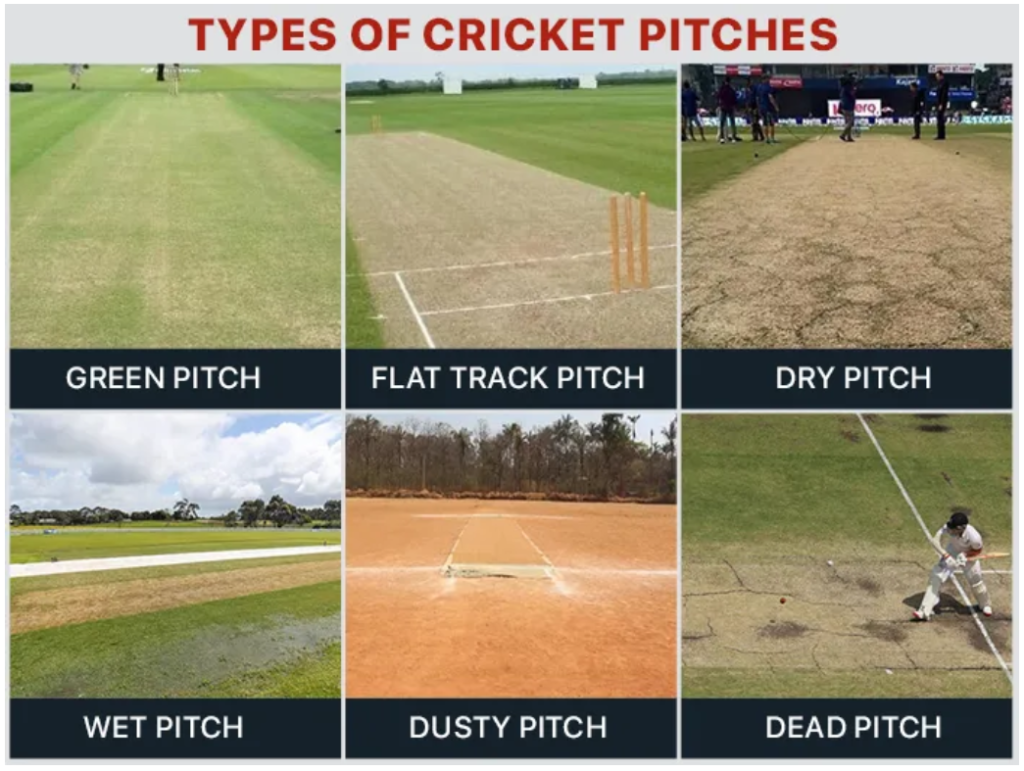Cricket Pitch serve as a vital element in the cricket field, having a significant impact on the course and capacity of a cricket match. The length of a Cricket Pitch as per the Cricket rule is 22 yards or 20.11 meters. A carefully designed and well-maintained cricket pitch can foster an even and demanding competition between bat and ball, enabling players to showcase their skills and strategies. At the core of cricket is the trinity of pitch, runs and wickets and in this article we will discuss about the different types of cricket pitches.
Beyond their role in sport, cricket pitches hold cultural significance, woven into the fabric of societies around the world where cricket is an important part of life. By providing a platform for players to showcase their talents and thrill fans, cricket pitches play a vital role in furthering the values of the game including teamwork, sportsmanship and fair play. Cricket associations and ground staff are responsible for ensuring that cricket pitches are carefully prepared and maintained, thereby promoting the continued growth and prosperity of the game.
Different Types of Cricket Pitch:

- Green Pitch
A natural pitch adorned with abundant grass, a green pitch or “green top” remains moist for a longer period of time, making it ideal for Test cricket. Recognized for its bowler-friendly characteristics, it creates challenges for the batsmen due to significant swing and seam movement, giving fast bowlers a chance to showcase their strengths.
- Dead Cricket Pitch
Flat and devoid of adequate grass and moisture, a dead pitch is unsuitable for Test matches. Designed for limited overs cricket, its flatness can present challenges for batsmen as the match progresses, with wear and tear creating an unpredictable surface.
- Dusty Cricket Pitch
Soft and covered in dust, the dusty pitch helps spin bowlers and still provides fair conditions for batting. This introduces an element of unpredictability into the contest, posing challenges for both batsmen and bowlers depending on various factors.
- Flat Track Pitch
Featuring a flat surface with minimal or no grass, flat track pitches cater to the batsmen’s preferences. Spin and fast bowlers often struggle on this track, leading to high-scoring matches and a challenging environment for bowlers to create opportunities.
- Dry Pitch
The dry pitch lacking moisture and full of cracks is favorable for fast bowlers. Ball speed becomes difficult for batsmen to predict, resulting in low-scoring matches where bowlers may find it easier to take wickets.
- Wet Pitch
High moisture content characterizes a wet pitch, making it unfavorable for batting. The slow ball speed and slippery conditions create challenges for both batsmen and fielders, making the match difficult.
What are the Qualities of Good Cricket Pitch:
A quality cricket pitch must exhibit specific characteristics to ensure an even contest and exciting play:
- Continuity: Providing consistent bounce and momentum throughout the game.
- Balance: Maintaining proper balance between batting and bowling.
- Grip: Providing adequate grDurability: To withstand the rigors of a long cricket match
- Durability: To withstand the rigors of a long cricket match without excessive wear.
- Safety: Ensuring a safe playing surface, reducing the risk of injuries.
- Character: Offering a unique challenge to both teams, testing their skills in various aspects.
Types of Soil used in Cricket Pitch:
The soil composition of a cricket pitch plays an important role in determining its quality and playing characteristics. A well-balanced soil profile includes:
- Topsoil: A mixture of sand, clay and loam, providing a well-drained surface.
- Subsoil: Usually composed of clay or loam, which provides stability to absorb player impact.
- Gravel layer: Facilitates drainage and stability.
- Water Table: Is in ideal condition to ensure proper moisture content without excessive dryness or wetness.
Cricket Pitch has to be well maintained, Maintenance practices such as aeration, fertilization and topdressing contribute to the management of the soil profile, ensuring the lasting quality and stability of the pitch over time.
A good Cricket Pitch leads to a competitive cricket match. The example of greatest rivalries of all time could be India vs Pakistan, Australia vs England (Ashes) etc.
Reference: ICC Cricket Wicket to Wicket










